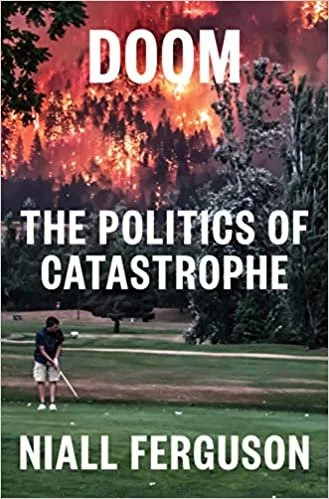Doom: the Politics of Catastrophe by Niall Ferguson
Published in late 2020, when we were half-way through (I hope!) the COVID pandemic, this is an timely (some might say premature) overview of historical catastrophes and how human systems respond to them, with a special focus on the current global convulsion. Humans are fascinated by the apocalypse, it is a perennial theme in religion, literature (especially science fiction) and movies…but predictions of the same have been consistently wrong for millennia. Norman Cohen’s Pursuit of the Millenium is the classic work in this regard and traces the history of millenarian movements from the Middle Ages to Marxism. These were plagues of the mind and they accompany pandemics. Examples include the flagellants during the 14th C Black Death and the BLM protests during the summer of 2020: both aimed at expiation of sin to appease heaven and fend off divine wrath as manifest by the pandemic. In the case of climate change, Greta Thurnberg is the child saint prophesying the apocalypse; the problem is that no one really wants to take practical measures to mitigate the consequences, they’re all gnashing their teeth about guilt and impractical visions of anti-capitalist long-term cures. Human nature never changes, and our responses to disaster fundamentally do not change as a result of technological changes. Ferguson says the best contrast to the current pandemic were the 1957-58 flu epidemic, very well managed by the Eisenhower administration and the best analogy is the 1980s HIV/Aids epidemic. The latter in particular, was to sex life what COVID has been to social life. “Safe sex” was imperative for a while, but has now drifted into obscurity….he suspects that such will be the fate of most of the measures put in place to halt the spread of the coronavirus.
Ferguson reviews disasters, natural and manmade and concludes that the worst are pandemics and wars. He looks at theories of history and their relevance as predictive tools for disasters vs power law distribution of highly unlikely but very consequential events (Grey Rhinos, Black Swans and Dragon Kings). The ability to contain contagion is the key factor for mitigating disasters and the size and structure of the impacted human networks determines this. The smaller the nodes of the network and the less connections they have with other nodes, the more likely they are to survive, hence the effectiveness of “social distancing” and quarantines.
My general criticism of the first three quarters of the book is that it is an almost overwhelming compilation of data, quotes, sources and (nearly illegible) graphs and charts that leave one reeling and craving more disciplined summary and analysis.
The last four chapters are on COVID-19, the policy response and its economic consequences. Politics, science and their intersection are are entertaining and troubling aspects of our current situation. Everything (including previously uncontroversial measures, like vaccines) has become a partisan issue. “The science” has taken a huge hit in public opinion due to the early and continuing misapplication of imperfect knowledge and hypotheses to formulate policies that turned out to unsupported by science, but for political reasons couldn’t be retracted. The public health bureaucracy manifestly failed at the beginning of the pandemic (e.g. CDC’s screwing up testing), even though the media and his political opposition blamed everything on Trump.
Ferguson draws analogies with the Challenger space shuttle disaster, where engineers knew the probability of failure of the O-rings on the engine with low temperatures (which these estimated at 0.1), but middle managers and bureaucrats suppressed this (<0.001) in the interest of advancing the launch.
On paper the US was arguably the best prepared country for a pandemic in the world in 2019: there were multiple plans but too many agencies with their hands in the batter. The plans may have been too specific and detailed, such as to render them impractical and not actionable in circumstances not matching the exact ones they were designed for.
The treatment of the rise of authoritarian China, post-COVID as the major competitor to Western liberal democratic capitalism is much more coherent and makes for good, if depressing, reading.


